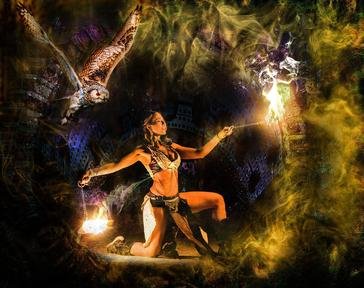Quiz Answer Key and Fun Facts
1. Since we're in Australia, Bob decided to start with lessons that would prepare him for the bush dance his local football club was planning to hold as a fundraiser. Which of these dances would he NOT be likely to be taught at his Wednesday afternoon lessons?
2. Bob was intrigued at the name of the class that was about to start when he was visiting the dance school on Tuesday afternoon, and asked if he could watch a lesson before deciding whether it would be his cup of tea. What is the distinguishing characteristic of the Indonesian topeng?
3. Classical Indian dance lessons are offered at our dance school on Friday mornings. Bob is considering a trip to India to watch the IPL, and thought he might learn a bit of traditional Indian dancing so he would be able to discuss it intelligently after the cricket had finished for the day. Which of these is one of the classical dance styles of India?
4. Bob has heard of the Japanese Kabuki and Noh traditions, but our local dancing school doesn't teach anything that elaborate in the Japanese dance lessons offered on Monday evenings. Which of these is a dance traditionally performed during a festival honoring the spirits of the dead?
5. Hula lessons are available on Thursdays at 11am. Bob has heard of the hula, and associates it with the Hawaiian islands. He was surprised to learn that there are a number of other places where very similar dances (to be honest, they look pretty much the same to him) are traditionally performed. Which of these island nations is NOT one of them?
6. Waiting for his next class to start at our local dance studio, Bob was intrigued to see some men going into the next dance studio wearing bells around their legs, and carrying handkerchiefs and sticks into the room. What type of dance lesson was about to start next door?
7. Bob signed up to learn how to dance with two women at once, something he thought would be a social asset if he ever accidentally invited two women out on the same night. Which of these Russian dances is definitely included in the classes he takes on Monday mornings?
8. Inspired by his Russian dance lessons, Bob decided to move on to learn the semi-official dance of the Ukraine, which he refers to as Cossack dancing. By what name is this dance more formally known?
9. Bob enrolled in a course of lessons on traditional Greek dancing so that he could replicate Zorba's dance in the 1964 movie 'Zorba the Greek'. Is Zorba's dance a traditional Greek dance?
10. Bob decided to sign up for the special "Macarena Day" workshop at our dance school. This dance is performed to a song which has been released a number of times, with slightly different musical forms. What dance form was the original 1992 release from Los Del Rio written in?
Source: Author
looney_tunes
This quiz was reviewed by FunTrivia editor
LadyCaitriona before going online.
Any errors found in FunTrivia content are routinely corrected through our feedback system.
